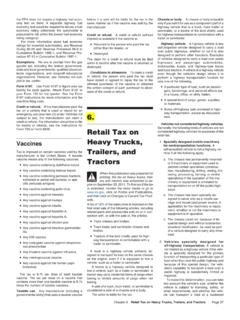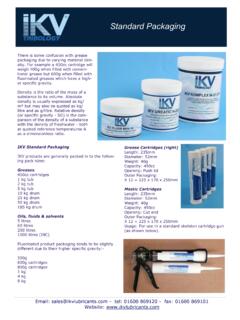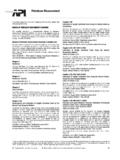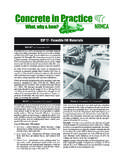Transcription of 240 Owner's Manual - Ben Lee
1 RAR-240 Series Trailer Air-Ride Suspensions Owner's Manual Box 4586 z Springfield, MO 65808 z z (fax). 0711. Suspension Identification: Ridewell Suspensions are identi ed by a metal tag attached to the left-hand hanger that indicates part number, revision level, & serial number. Parts: For optimum suspension performance, order only Ridewell parts. Replacement parts for RAR-240 are shown on pages 13-16 of this Manual . Sales, Service & Warranty: If you need assistance regarding this product, please contact us and we will be glad to help you. Mailing Address Shipping Address Phones, Fax, E-mail Ridewell Corporation Ridewell Corporation , Box 4586 3715 East Farm Rd. 94 (fax). Springfield, MO 65808 Springfield, MO 65803 RAR-240 Owner's Manual Contents Pre-Installation Installation - Installation - Axle to Installation - Suspension to Axle Torque Height Control System Bushing Check Bushing Replacement Weld Parts Maintenance Pre-Installation Notes 1. Suspensions are designed to operate within speci c parameters.
2 Operating the suspension outside the design paramaters may result in improper performance, damaged equipment, and voiding of the warranty. 2. The total operating capacity of a suspension / running gear system is determined by the component with the lowest road rating. Please consult with the manufacturers of axles, brakes, tires and wheels to determine the maximum suspension system capacity. 3. The installer is responsible for ensuring that air volume requirements are met. Consult Federal Motor Vehicle Safety Standards (FMVSS) 121 for more information. 4. Welding or altering suspension components is not permitted except where publicly stated by Ridewell Corporation. 3. RAR-240 Owner's Manual Chart 1. TIRE LOADED RADIUS. Configuration The Ridewell model RAR-240 suspension is designed to accommodate a range of ride heights for each speci c model and can be used on a variety of axle types for various applications. The following characteristics are commonly referenced for set-up of the suspension: 1.
3 Ride Height (also called Mounting Height) - The distance from the bottom of the trailer frame to the centerline of the axle. Ride height is related to frame height (the distance from the bottom of the frame to the ground) by the following formula: Ride Height = Frame Height - Loaded Tire Radius The loaded tire radius for common tire sizes can be found in Chart 1. 2. Beam Centers - The centerline-to-centerline distance from one axle seat to the other. For the RAR-240, this is also the same as the centerline-to-centerline distance from one hanger to the other. The RAR-240 is designed to t up onto standard I-beam trailer frames at beam centers that correspond to standard axle track widths as shown below with standard wheel-end equipment. Installation at wider beam centers will reduce suspension clearances; installation at narrower beam centers will de-rate the axle beam capacity per the axle manufacturer's speci cations. For non-standard beam centers, frames, frame centers, axle track or wheel-end equipment, the installer is responsible for verifying clearances, axle capacity, proper t-up, and any additional required support structure.
4 Standard Trailer Dimensions Trailer Width Axle Track Frame Centers Beam Centers Air Spring Centers 96 38 35 31 . 102 44 41 37 . Installation - General 1. See the applicable RAR-240 engineering drawing for all dimensional requirements, part numbers, assembly details, torque values, etc. referred to in the installation procedures. 2. The exact sequence of installation and assembly of the suspension, installation of the height control system, and completion of the axle alignment procedure is at the discretion of the trailer manufacturer. 4. RAR-240 Owner's Manual Installation - Axle to Suspension 1. A xture to support the axle and suspension during the welding process is recommended. Ridewell o ers weld xture 953386. 2. Verify the beam centers and center the axle in the axle seats. 3. For drum brake axles, space the cam o the tail of the beam per the drawing and ensure that the brake chamber brackets are oriented properly. For disc brake axles, ensure that the caliper assemblies are oriented properly and are rotated to proper position.
5 4. Check the gap between the axle and the bottom of the axle seat at each end of each seat. No gap greater than 1/16 allowed before clamping. After clamping the axle into the axle seats, no gap is allowed. 5. Weld the axle to the suspension trailing arms per Ridewell Weld Process #1 (see page 12). Installation - Suspension to Frame Note: The procedure in this section is recommended by Ridewell. Minor deviations from these guidelines are permitted, especially in the details of welding the suspension to the trailer. The installer has ultimate responsibility for attachment of the suspension to the trailer. 1. Locate and mark the proper location of the suspension hangers and air spring plates on the trailer frame. The frame must be clear in this area for proper suspension t-up. 2. Frame cross members should be located as shown on the drawing. 3. Fabricate ller plates approximately as shown on the drawing and weld to the crossmembers with llet welds (it is recommended to place welds down the length of the crossmember, not across it) and butt weld to frames.
6 At the hanger, a single large ller plate in place of the two small ones may be preferable. 4. Locate and weld the hangers to the frame and ller plates with llet welds. Stop welds approximately from corners and edges. A diameter piece of pipe may be placed through the holes in the hangers during this step as a stabilizer and aligning aide. 5. Weld the air spring support plate to the frame and ller plate in similar fashion with 3/16 llet welds. 6. If required, locate a crossmember (or diagonal braces) to the front of the hangers as shown on the drawing and attach with llet welds. 7. All welds to be 70 ksi min. tensile strength. GMAW or FCAW recommended. 8. Assemble air springs and shock absorbers per the drawing. 5. RAR-240 Owner's Manual Axle Alignment The RAR-240 suspension is equipped for simple, Manual alignment of the axles. There is 1/4 of available adjustment at each hanger. 1. Prior to alignment, ensure all the eccentric bolt pointing arrows are at the 12 o'clock position. See Figure 1.
7 2. Align the forward axle to the center of the kingpin to within 1/8 . See Figure 2. 3. Alignment procedure: a. Loosen the pivot nut and remove anti-turn washer if necessary. b. To move the axle, turn the head of the eccentric bolt in the direction the axle is to be moved. Maximum movement of the eccentric bolt pointing arrow from the 12 o'clock position is to the 9 o'clock or 3 o'clock position. The eccentric bolt pointing arrow should never be pointing below horizontal. c. With eccentric bolts at their nal setting, install anti-turn washers over the bolt heads and weld to hangers. See Figure 3. d. Torque the pivot nuts to 1,000 ft-lbs. Note: Torque the pivot nuts with the suspension at ride height to prevent pre-stressing the rubber pivot bushing. Note: It is imperative that the pivot nuts be fully torqued prior to placing the trailer into service. Failure to torque the pivot nuts will lead to slippage of the pivot joint, causing rapid wear of the hanger holes and the bushing sleeve, and ultimately leading to catastrophic failure of the suspension.
8 A tag on the suspension and a label in the carton of parts are provided to specify the torque of all the suspension fasteners (see Figure 4). The label should be adhered to the trailer frame above the suspension. Warranty coverage of the suspension is void if the pivot nuts are not fully torqued. e. Final check the alignment measurements and re-adjust if necessary. 4. Align the aft axle(s) to the forward axle to within 1/16 using the same procedure. See Figure 2. 6. RAR-240 Owner's Manual Figure 1. YOUR SUSPENSION WILL HAVE THIS. LABEL ABOVE THE ECCENTRIC BOLT. NOTICE! ECCENTRIC BOLT ARROW. MUST BE AT 12 O'CLOCK. POSITION PRIOR TO. ALIGNMENT. AFTER. ALIGNMENT INSTALL. ANTII-TURN WASHER OVER. HEAD OF BOLT AND TORQUE. TO 1,OOO FT. LBS. Figure 2. Figure 3. 1/4 FILLET WELDS, 1 LONG, AFTER AXLE. IS ALIGNED. 7. RAR-240 Owner's Manual Torque Requirements Design torque on all suspension fasteners must be SET AND MAINTAINED BY INSTALLER. Figure 4. This torque label, included in the carton of parts, should be adhered to the chassis above the suspension.
9 #1990017. MONOPIVOT 240 BOLT TORQUE. MINIMUM SPECIFICATIONS. ECCENTRIC PIVOT BOLT 1,000 FT. LBS. (1,350 N m). SHOCK BOLT 160 FT. LBS. (220 N m). AIR SPRING CONNECTION-3/4 50 FT. LBS. (70 N m). AIR SPRING CONNECTION-1/2 25 FT. LBS. (35 N m). After suspension has been in operation for approximately 6,000 miles (10,000 km), all fasteners must be re-tightened to specified torque. Repeat every 50,000 miles (80,000 km). DO NOT OVER TORQUE! See Service Manual for Details 8. RAR-240 Owner's Manual Height Control System Installation Install the appropriate height control valve, linkages, etc. per the Extreme AirTM Height Control Valve Installation and Operations Guide for model RAR-240. Bushing Check Procedure The bushings in the RAR-240 suspension should be checked during any scheduled maintenance or any time there is a suspected problem. Bushing problems can arise from breakdown of the natural rubber over time or, in a severe application, by failure of the bond between the rubber and the metal inner sleeve.
10 The bushings should be checked if any of the following conditions are observed: 1. Uneven tire wear. 2. Abnormal forward-aft or lateral movement of the axle during operation. 3. Rapid degradation of wear washers. 4. Abnormal noises coming from the suspension. To check, insert the at end of a pry-bar between the sidewall of the hanger and the eye of the beam. Applying moderate side load to the pry-bar, look for any relatively large or easy movement of the beam in relation to the hanger. Note that a small amount of movement under load due to de ection of the rubber is normal and acceptable. Repeat the process on the other side of the hanger. If large or easy movement is noted, drop the beams down per the bushing replacement procedure for further inspection of the bushing and replace if necessary. 9. RAR-240 Owner's Manual Bushing Replacement Procedure RAR-240 Underslung or Overslung Suspension 1. Raise and safely block up trailer and axle. Remove wheels and tires. Remove shock absorbers from suspension.





